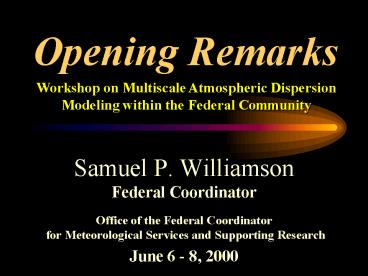Opening Remarks - PowerPoint PPT Presentation
1 / 21
Title:
Opening Remarks
Description:
Opening Remarks Workshop on Multiscale Atmospheric Dispersion Modeling within the Federal Community Samuel P. Williamson Federal Coordinator Office of the Federal ... – PowerPoint PPT presentation
Number of Views:204
Avg rating:3.0/5.0
Title: Opening Remarks
1
Opening Remarks
Workshop on Multiscale Atmospheric Dispersion
Modeling within the Federal Community
- Samuel P. Williamson
- Federal Coordinator
- Office of the Federal Coordinator
- for Meteorological Services and Supporting
Research - June 6 - 8, 2000
2
Overview
- Welcome
- Workshop Context - Why are we here?
- Expected Outcomes
3
Welcome to Silver Spring
Workshop on Multiscale Atmospheric Dispersion
Modeling within the Federal Community
June 6 - 8, 2000 Town Center Hotel Silver Spring,
Maryland
4
Welcome to Silver Spring
OFCM Informational Brochure
In your folder...
Metro System Guide
Maps and Dining Guide
5
Why are we here?
CNN/KATC-TV photo
CNN/KATC-TV photo
Eunice, LA. (Reuters) - Hazardous-chemical
specialists plan to put out fires still burning
in two tank cars of plastics Tuesday and then
begin moving some of 30 freight cars that
derailed Saturday in southwest Louisiana, forcing
2,500 people from their homes.
Residents were ordered to flee from a 2-1/2-mile
radius around the site within minutes....
Dense smoke poured from the scene for almost 24
hours, police said.
... dichloropropane, acrylic acid, methyl
chloride, toluene, diisocyanate, sodium
hydroxide, hexane, and phenol.
AP Photo/Civil Air Patrol - Rock Palermo
May 27, 2000 - Eunice, Louisiana
6
Sources
Natural
Anthropogenic
Pesticides
Dust/Sand Storms
Oil Spills VOCs
7
Cross-cutting agency interests...
Natural
Anthropogenic
Emergency Response
Pollution
Volcanic Ash
Economic Vitality
Pesticides
Dust/Sand Storms
National Security
Nuclear, Biological, and Chemical
Transportation Safety and Efficiency
Allergens
Regulatory Activities
Oil Spills VOCs
Lightning-Induced Forest Fire Smoke
Public Health
Ozone Depleting Chemicals
Human-Induced Forest Fires
Quality of Life
8
Expected Outcomes
9
Expected Outcomes
Verification, Validation, and Approval Methods
Session 4
Selecting subsets to meet applications needs
10
Summary
- Potential for ATD modeling to touch every aspect
of our lives - effects demonstrated daily - Growing concerns over chemical and biological
terrorism demand attention - This workshop will let us assess where we are and
set a direction for the future
11
(No Transcript)
12
Opening Remarks
Workshop on Multiscale Atmospheric Dispersion
Modeling within the Federal Community
- Dr. Darryl Randerson
- Chief, Special Operations and Research Division,
- Air Resources Laboratory, NOAA
- Chairman, Joint Action Group for
- Atmospheric Transport and Diffusion
- June 6, 2000
13
Workshop Goal
Improve agency coordination in the development
and operational use of dispersion models.
14
Workshop Objectives
- State current modeling requirements and
capabilities - Specify new requirements/unmet needs
- Describe existing methods for validation,
verification, and approval of current models and
future needs - Describe a process for establishing model subsets
for specific applications - Find solutions to agency-identified technical
barriers - Identify opportunities for leveraging model
development and model validation, verification,
and approval
15
Session 1
Tuesday morning
- User Requirements for Dispersion Modeling
- Agencies current requirements
- How current requirements are being met
- New/unmet requirements
16
Session 2
Tuesday afternoon
- Agency Dispersion Modeling Capabilities
- What models are currently used for operations?
- How does modeling capability meet agency
requirements? - How are models evaluated?
- Who are the users what products are distributed
what are training requirements? - Research/development for unmet user needs
17
Session 3
Wednesday morning
- Technical Barriers to Dispersion Modeling
- Turbulence and the stable boundary layer
- Air-surface exchange
- Probabilistic modeling
- Mesoscale and surface layer transport
- Neighborhood-scale processes
18
Session 4
Wednesday afternoon
- Model Validation, Verification, and Approval
Model Subsets - Develop a framework for the validation,
verification, and approval of dispersion models - Identify subsets of scientifically and
technically sound models suitable for different
operational scenarios
19
Session 5
Thursday morning
- Summary and Wrap-Up
- Panel and breakout chairs report results and
recommendations - Next steps/follow-on actions
- Closing remarks
20
Lets get started...
Session 1 User Requirements for Dispersion
Modeling
Session Chair Rickey Petty, DOE Rapporteur
Roger Stocker, DOD/USN
21
(No Transcript)































